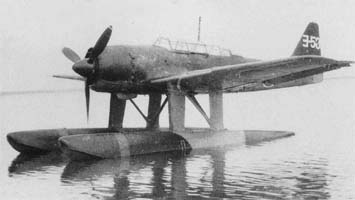The Pacific War Online Encyclopedia: E16A "Paul", Japanese
Reconnaissance (original) (raw)
| ![]() The Pacific War Online Encyclopedia | |
| -------------------------------------------------------------------------------- | |
The Pacific War Online Encyclopedia | |
| -------------------------------------------------------------------------------- | |
AichiE16A1 Zuiun ("Auspicious Cloud") "Paul"
| Crew | Two in tandem cockpit |
|---|---|
| Dimensions | 42'0" by 35'7" by 15'9"12.81m by 10.83m by 4.79m |
| Wing area | 301 square feet28 square meters |
| Weight | 6,493-10,038 lbs2945-4553 kg |
| Speed | 273 mph at 18,045 feet439 km/h at 5500 meters |
| Cruising speed | 207 mph at 16,405 feet333 km/h at 5000 meters |
| Climb rate | 35 feet per second10.7 meters per second |
| Ceiling | 32,810 feet10,000 meters |
| Power plant | One 1300 hp (970 kW) MitsubishiMK8A Kinsei 51 14-cylinder air-cooled radial engine driving a three-blade constant-speed metal propeller. |
| Armament | Two wing-mounted 7.7mm Type 97 machine gunsOne flexible 13mm Type 2 machine gun in the rear cockpit |
| External stores | 2 250 kg (551 lb) bombs |
| Range | Normal 731 miles (1180 km)Maximum 1,504 miles (2420 km) |
| Production | A total of 256 E16As were built.Aichi Kokuki K.K., Eitoku: 3 E16A1 prototypes (1942) 193 E16A1 production aircraft (1944-1 to 1945-5) 1 E16A2 prototype (1944) Nippon Hikoki K.K. at Tomioka: 59 E16A1 production aircraft (1944-8 to 1945-8) |
| Variants | Late production aircraft were powered by the 1300 hp (970 kW) MK8D Kinsei 54. This engine differed little from the Kinsei 51 in performance. |
"Paul" was the replacement for the E13A "Jake"but did not come into service before the Japanese had lost control of the air. Requirements were first drafted in 1939, before "Jake" had even come into full production, but disagreements over the requirements prevented serious design work until October 1940, when a team lead by Matsuo Kishiro and Ozawa Yasushiro began drafting the new design. The prototype was completed in May 1942 and was of all-metal construction except for wingtips, tailplane and some control surfaces. The wings could be folded for storage. The type went into production in August 1943.
"Paul" suffered heavy losses in the Philippines, and most of the survivors were expended as kamikazesin the Okinawacampaign. Oddly enough, it was designed to be capable of dive bombing, being equipped with dive brakes on the forward float struts.
References
The Pacific War Online Encyclopedia © 2007-2009 by Kent G. Budge. Index

